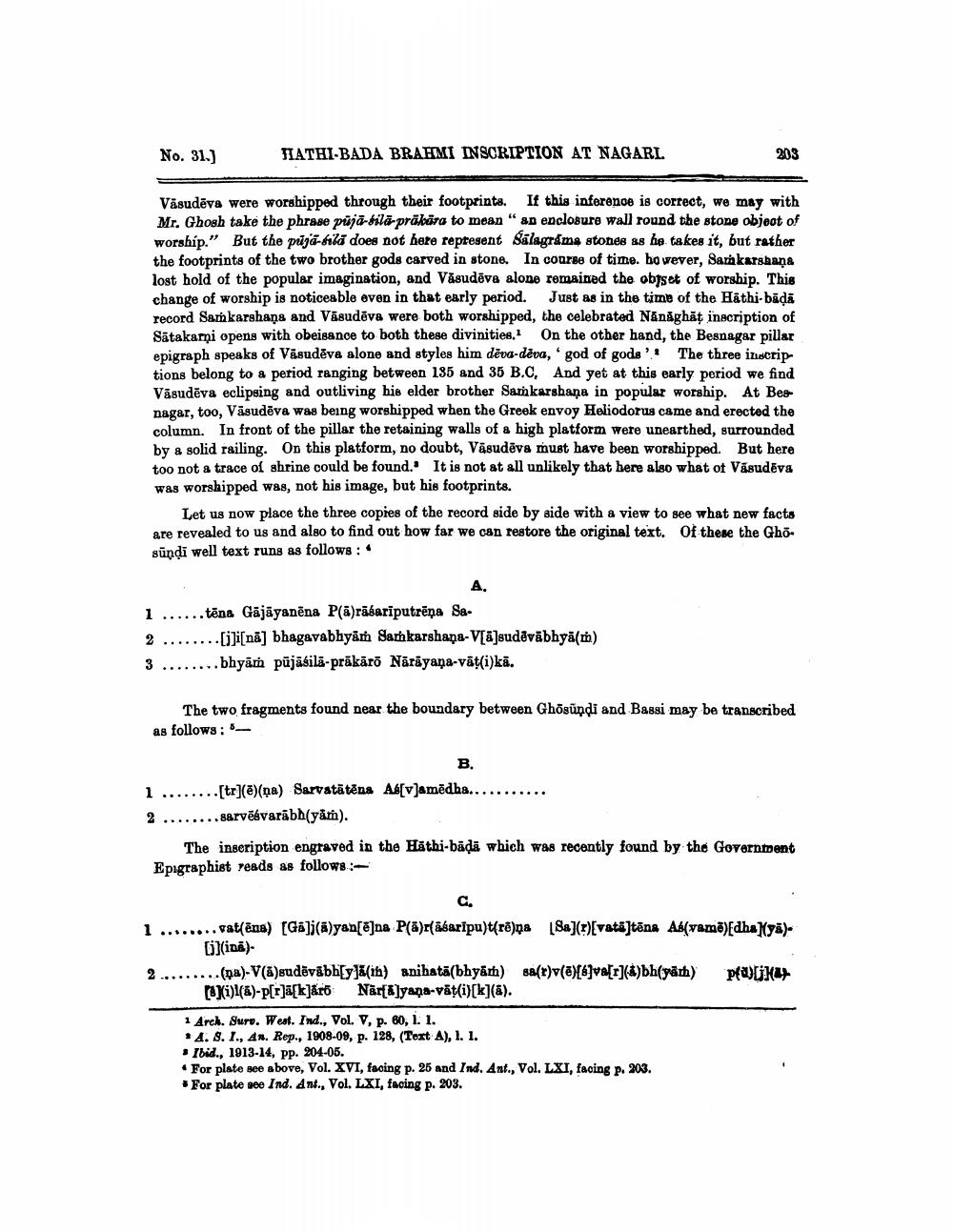________________
No. 31.)
MATHI-BADA BRAHMI INSCRIPTION AT NAGARI.
203
Vāsudēva were worshipped through their footprints. If this inference is correct, we may with Mr. Ghosh take the phrase püja-bilä präkära to mean" an enclosure wall round the stone objeot of worship." But the prija-bila does not here represent sālagráme stones as he takes it, but rather the footprints of the two brother gods carved in stone. In course of time. however, Sarkarshana lost hold of the popular imagination, and Vasudēva alone remained the obset of worship. This change of worship is noticeable even in that early period. Just as in the time of the Hathi-bāda record Samkarshana and Vasudeva were both worshipped, the celebrated Nănăghāt inscription of Satakarni opens with obeisance to both these divinities. On the other hand, the Besnagar pillar epigraph speaks of Vāsudēva alone and styles him dēva-dēva, 'god of gods!! The three inscrip tions belong to a period ranging between 135 and 35 B.C. And yet at this early period we find Vásudēva eclipsing and outliving his elder brother Samkarshana in popular worship. At Bes nagar, too, Vāsudēva was being worshipped when the Greek envoy Heliodorus came and erected the column. In front of the pillar the retaining walls of a high platform were unearthed, surrounded by a solid railing. On this platform, no doubt, Vāsudēva must have been worshipped. But here too not a trace of shrine could be found. It is not at all unlikely that here also what of Vasudēva was worshipped was, not his image, but his footprints.
Let us now place the three copies of the record side by side with a view to see what new facts are revealed to us and also to find out how far we can restore the original text. Of these the Ghosündi well text runs as follows:
A. 1 ......tēna Gājāyanēna P(ā)rāśarīputrēna Sa2 ..........[j]i[nā] bhagavabhyāṁ Sarkarshana-V[a]sudėvābhyā(m)
........ bhyām pūjāsilā-prākāro Nārāyaṇa-vāt(i)kā.
The two fragments found near the boundary between Ghosūņdi and Bassi may be transcribed as follows: 5
1 ........ (tr)(a)(na) Sarvatātēna Ab[v]amëdha...... 2 ........ sarvēsvarābh(yam).
The inscription engraved in the Hathi-bādā which was recently found by the Government Epigraphist reads as follows:
...vatsēna) (Gá]i(a)yan[ē]na P(a)r(āśarīpu)t(rē)ņa (Sa}(t){vatā]tēna Ab(vamē)[dhayā).
[]}(in.). 2 .........(pa)-V(ā)gudēvábh[y]/in) anihatā(bhyarh) 88/r)vlē)[b]va[r](á)bh(yarh) palik
Xi)l(a)-P[1]a[k]áró Nār[&]yana-vāt(i)[k](a). 1 Arch. Suro. West. Ind., Vol. V, p. 60, 1. 1. 14. 8. I., An. Rep., 1908-09, p. 128, (Text A), l. 1. • Ibid., 1913-14, pp. 204-05. • For plate see above, Vol. XVI, facing p. 25 and Ind. Ant., Vol. LXI, facing p. 203. * For plate see Ind. Ant., Vol. LXI, facing p. 203.




